Optimal Deception Asset Deployment in Cybersecurity: A Nash Q-Learning Approach in Multi-Agent Stochastic Games
Abstract
:1. Introduction
2. Related Work
3. System Model
3.1. Attacker Model
3.2. Defender Model
3.3. Construction of Maze Model
4. Construction of Attack–Defense Game Model
4.1. Stochastic Game Model
4.2. Quantification of Attack and Defense Benefits
5. Game Model Solution
5.1. Multi-Agent Reinforcement Learning Representations
5.2. Nash Q-Learning Based Multi-Agent Deception Deployment Solution Algorithm
| Algorithm 1 Nash Q-learning for stochastic game in maze pathfinding model. |
|
6. Experiment
6.1. Description of Simulation Environment
6.2. Simulation Parameter Setting
6.3. Simulation Experiment and Result Analysis
6.3.1. Algorithm Comparison
6.3.2. Result Analysis
Convergence Analysis
Optimal Strategy
7. Summary
Author Contributions
Funding
Institutional Review Board Statement
Informed Consent Statement
Data Availability Statement
Acknowledgments
Conflicts of Interest
References
- IT Giant Bitmarck Shuts Down Customer, Internal Systems after Cyberattack. Available online: https://www.theregister.com/2023/05/01/bitmarck_data_breach (accessed on 1 May 2023).
- Maritime Giant DNV Says 1000 Ships Affected by Ransomware Attack. Available online: https://techcrunch.com/2023/01/18/dnv-norway-shipping-ransomware (accessed on 18 January 2023).
- Portuguese Water Utility Attacked by LockBit. Available online: https://www.scmagazine.com/brief/portuguese-water-utility-attacked-by-lockbit (accessed on 22 February 2023).
- Yadav, T.; Rao, A.M. Technical aspects of cyber kill chain. In Proceedings of the Third International Symposium on Security in Computing and Communications (SSCC’15), SSCC 2015, Kochi, India, 10–13 August 2015; Springer: Berlin/Heidelberg, Germany, 2015; pp. 438–452. [Google Scholar]
- Bahrami, P.N.; Dehghantanha, A.; Dargahi, T.; Parizi, R.M.; Choo, K.-K.R.; Javadi, H.H. Cyber kill chain-based taxonomy of advanced persistent threat actors: Analogy of tactics, techniques, and procedures. J. Inf. Process. Syst. 2019, 15, 865–889. [Google Scholar]
- Lei, C.; Zhang, H.-Q.; Tan, J.-L.; Zhang, Y.-C.; Liu, X.-H. Moving target defense techniques: A survey. Secur. Commun. Netw. 2018, 2018, 3759626. [Google Scholar] [CrossRef]
- Sengupta, S.; Chowdhary, A.; Sabur, A.; Alshamrani, A.; Huang, D.; Kambhampati, S. A survey of moving target defenses for network security. IEEE Commun. Surv. Tutorials 2020, 22, 1909–1941. [Google Scholar] [CrossRef]
- Navas, R.E.; Cuppens, F.; Cuppens, N.B.; Toutain, L.; Papadopoulos, G.Z. Mtd, where art thou? A systematic review of moving target defense techniques for iot. IEEE Internet Things J. 2020, 8, 7818–7832. [Google Scholar] [CrossRef]
- Lu, Z.; Wang, C.; Zhao, S. Cyber Deception for Computer and Network Security: Survey and Challenges. arXiv 2020, arXiv:2007.14497. [Google Scholar]
- Wang, C.; Lu, Z. Cyber deception: Overview and the road ahead. IEEE Secur. Priv. 2018, 16, 80–85. [Google Scholar] [CrossRef]
- Cranford, E.A.; Gonzalez, C.; Aggarwal, P.; Tambe, M.; Cooney, S.; Lebiere, C. Towards a cognitive theory of cyber deception. Cogn. Sci. 2021, 45, e13013. [Google Scholar] [CrossRef] [PubMed]
- Zhang, L.; Thing, V.L. Three decades of deception techniques in active cyber defense-retrospect and outlook. Comput. Secur. 2021, 106, 102288. [Google Scholar] [CrossRef]
- Paxton, N.C.; Jang, D.-I.; Russell, S.; Ahn, G.-J.; Moskowitz, I.S.; Hyden, P. Utilizing network science and honeynets for software induced cyber incident analysis. In Proceedings of the 2015 48th Hawaii International Conference on System Sciences, Kauai, HI, USA, 5–8 January 2015; pp. 5244–5252. [Google Scholar]
- Franco, J.; Aris, A.; Canberk, B.; Uluagac, A.S. A survey of honeypots and honeynets for internet of things, industrial internet of things, and cyber-physical systems. IEEE Commun. Surv. Tutor. 2021, 23, 2351–2383. [Google Scholar] [CrossRef]
- Chi, C.; Wang, Y.; Tong, X.; Siddula, M.; Cai, Z. Game theory in internet of things: A survey. IEEE Internet Things J. 2021, 9, 12125–12146. [Google Scholar] [CrossRef]
- La, Q.D.; Quek, T.Q.; Lee, J.; Jin, S.; Zhu, H. Deceptive attack and defense game in honeypot-enabled networks for the internet of things. IEEE Internet Things J. 2016, 3, 1025–1035. [Google Scholar] [CrossRef]
- Çeker, H.; Zhuang, J.; Upadhyaya, S.; La, Q.D.; Soong, B.-H. Deception-based game theoretical approach to mitigate dos attacks. In Decision and Game Theory for Security, Proceedings of the 7th International Conference, GameSec 2016, New York, NY, USA, 2–4 November 2016; Proceedings 7; Springer: Berlin/Heidelberg, Germany, 2016; pp. 18–38. [Google Scholar]
- Pawlick, J.; Zhu, Q. Deception by design: Evidence-based signaling games for network defense. arXiv 2015, arXiv:1503.05458. [Google Scholar]
- Basak, A.; Kamhoua, C.; Venkatesan, S.; Gutierrez, M.; Anwar, A.H.; Kiekintveld, C. Identifying stealthy attackers in a game theoretic framework using deception. In Decision and Game Theory for Security, Proceedings of the 10th International Conference, GameSec 2019, Stockholm, Sweden, 30 October–1 November 2019; Proceedings 10; Springer: Berlin/Heidelberg, Germany, 2019; pp. 21–32. [Google Scholar]
- Anwar, A.H.; Kamhoua, C.; Leslie, N. Honeypot allocation over attack graphs in cyber deception games. In Proceedings of the 2020 International Conference on Computing, Networking and Communications (ICNC), Big Island, HI, USA, 17–20 February 2020; IEEE: Piscataway, NJ, USA, 2020; pp. 502–506. [Google Scholar]
- Sutton, R.S.; Barto, A.G. Reinforcement Learning: An Introduction; MIT Press: Cambridge, MA, USA, 2018. [Google Scholar]
- Amin, M.A.R.A.; Shetty, S.; Njilla, L.; Tosh, D.K.; Kamhoua, C. Online cyber deception system using partially observable monte-carlo planning framework. In Security and Privacy in Communication Networks, Proceedings of the 15th EAI International Conference, SecureComm 2019, Orlando, FL, USA, 23–25 October 2019; Proceedings, Part II 15; Springer: Berlin/Heidelberg, Germany, 2019; pp. 205–223. [Google Scholar]
- Wang, S.; Pei, Q.; Wang, J.; Tang, G.; Zhang, Y.; Liu, X. An intelligent deployment policy for deception resources based on reinforcement learning. IEEE Access 2020, 8, 35792–35804. [Google Scholar] [CrossRef]
- Huang, L.; Zhu, Q. Adaptive honeypot engagement through reinforcement learning of semi-markov decision processes. In Decision and Game Theory for Security, Proceedings of the 10th International Conference, GameSec 2019, Stockholm, Sweden, 30 October–1 November 2019; Proceedings 10; Springer: Berlin/Heidelberg, Germany, 2019; pp. 196–216. [Google Scholar]
- Zhang, H.; Liu, H.; Liang, J.; Li, T.; Geng, L.; Liu, Y.; Chen, S. Defense against advanced persistent threats: Optimal network security hardening using multi-stage maze network game. In Proceedings of the 2020 IEEE Symposium on Computers and Communications (ISCC), Rennes, France, 7–10 July 2020; IEEE: Piscataway, NJ, USA, 2020; pp. 1–6. [Google Scholar]
- Horák, K.; Bošanskỳ, B. Solving partially observable stochastic games with public observations. Proc. Aaai Conf. Artif. Intell. 2019, 33, 2029–2036. [Google Scholar] [CrossRef]
- Hu, J.; Wellman, M.P. Nash Q-learning for general-sum stochastic games. J. Mach. Learn. Res. 2003, 4, 1039–1069. [Google Scholar]
- Vamvoudakis, K.G. Non-Zero Sum Nash Q-Learning for Unknown Deterministic Continuous-Time Linear Systems. Automatica 2015, 61, 274–281. Available online: https://www.sciencedirect.com/science/article/pii/S000510981500343X (accessed on 5 September 2015). [CrossRef]
- Wei, C.-Y.; Hong, Y.-T.; Lu, C.-J. Online reinforcement learning in stochastic games. Adv. Neural Inf. Process. Syst. 2017, 30, 4994–5004. [Google Scholar]
- Zhang, K.; Yang, Z.; Başar, T. Multi-agent reinforcement learning: A selective overview of theories and algorithms. In Handbook of Reinforcement Learning and Control; Springer: Cham, Switzerland, 2021; pp. 321–384. [Google Scholar]
- Zhu, Y.; Zhao, D. Online minimax q network learning for two-player zero-sum markov games. IEEE Trans. Neural Netw. Learn. Syst. 2020, 33, 1228–1241. [Google Scholar] [CrossRef] [PubMed]
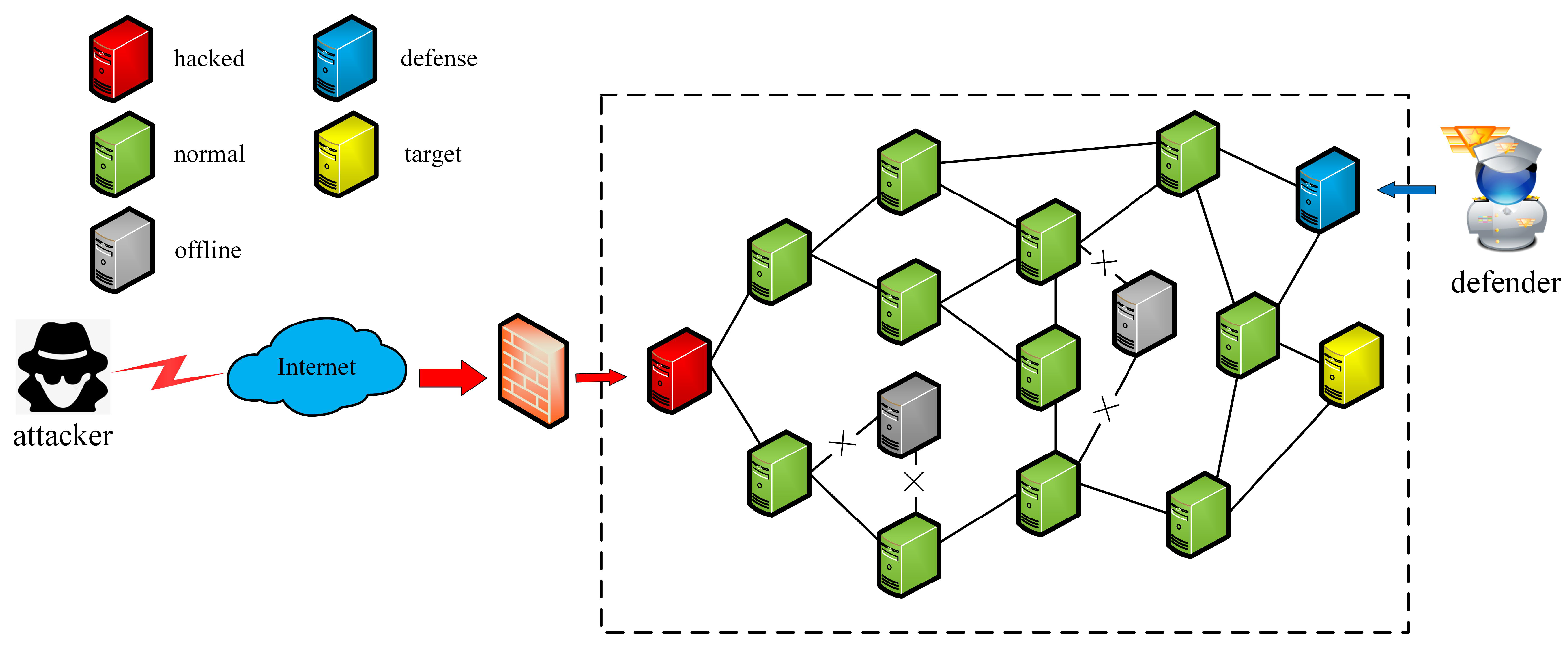
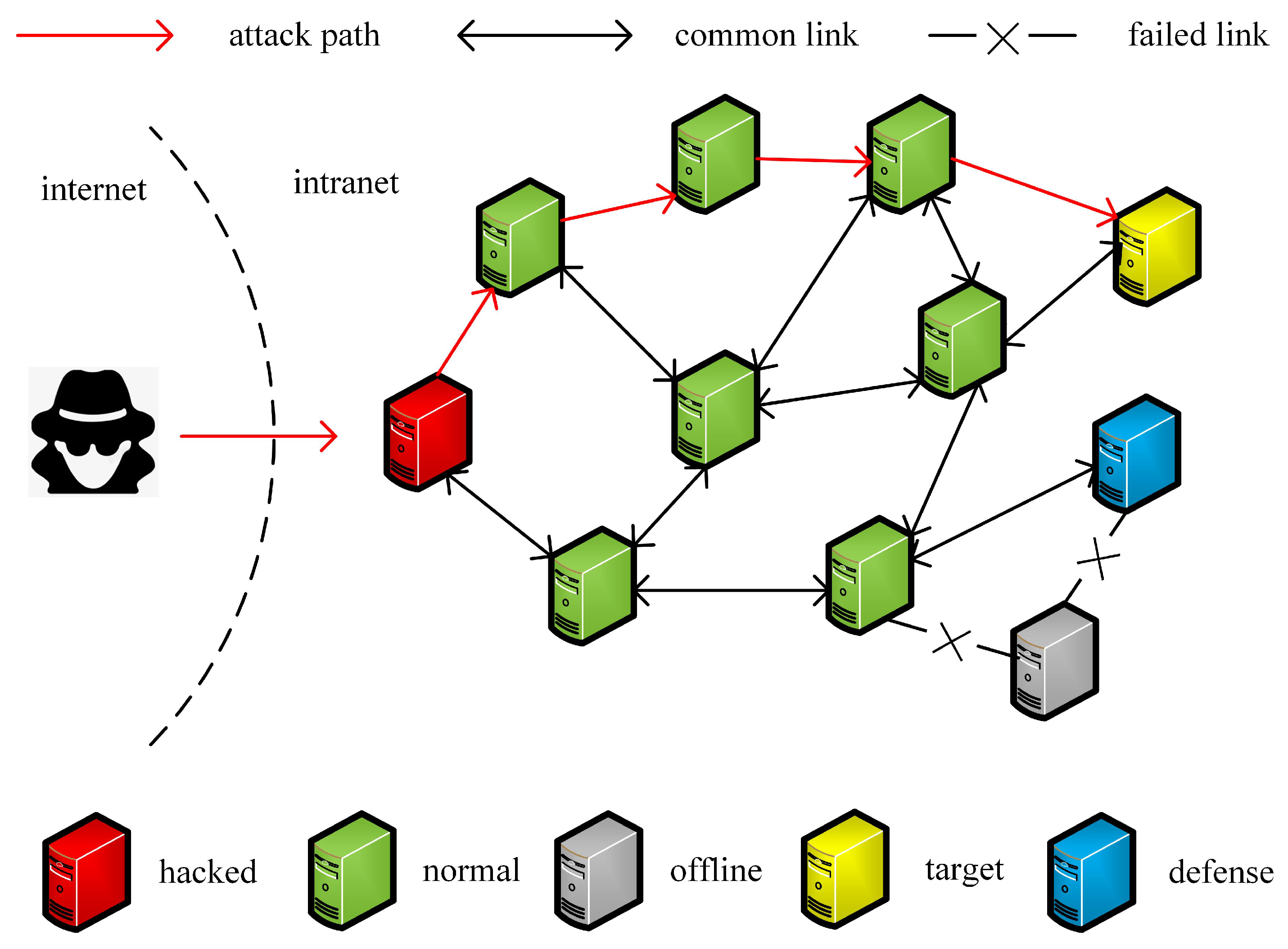
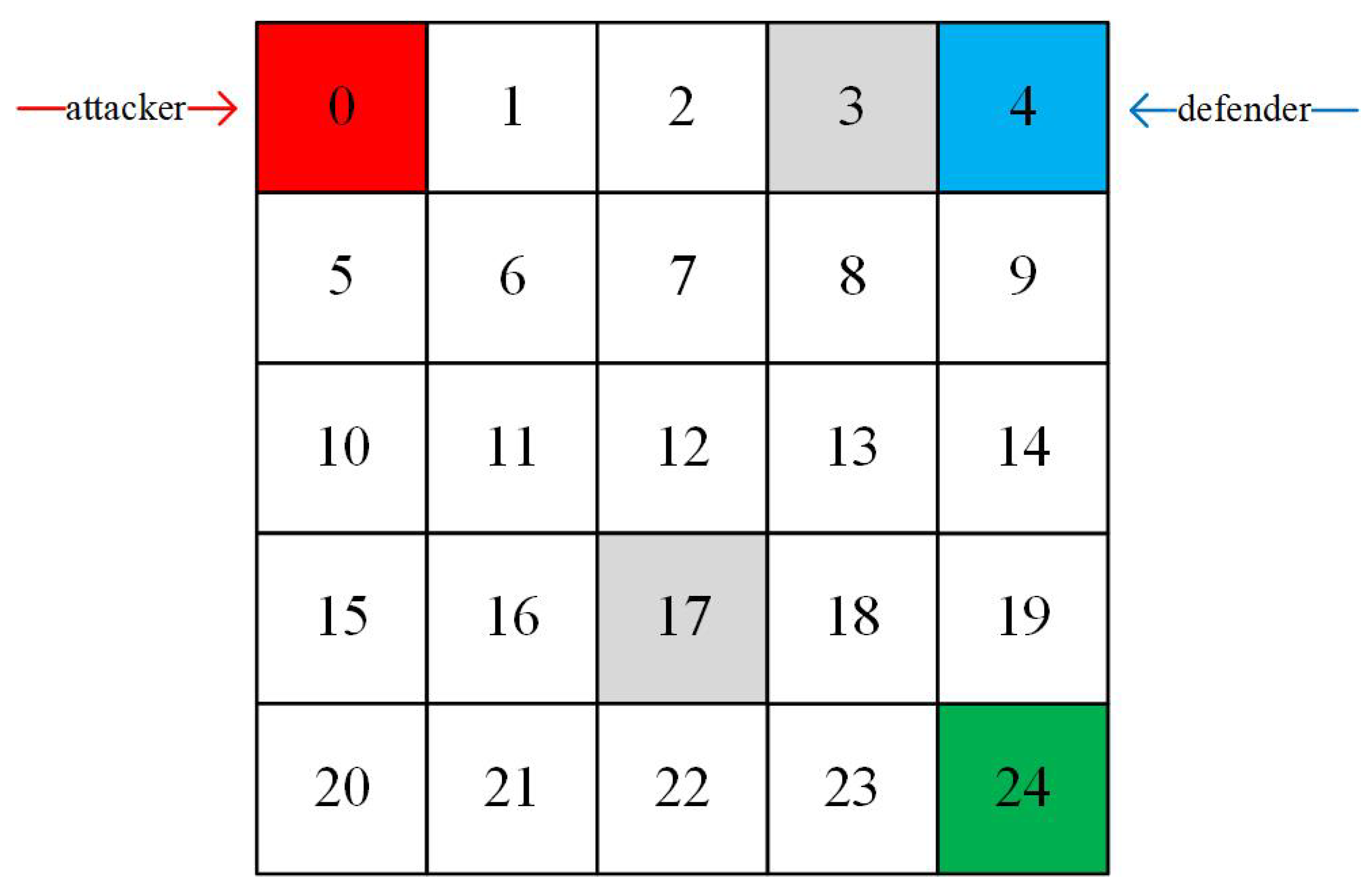
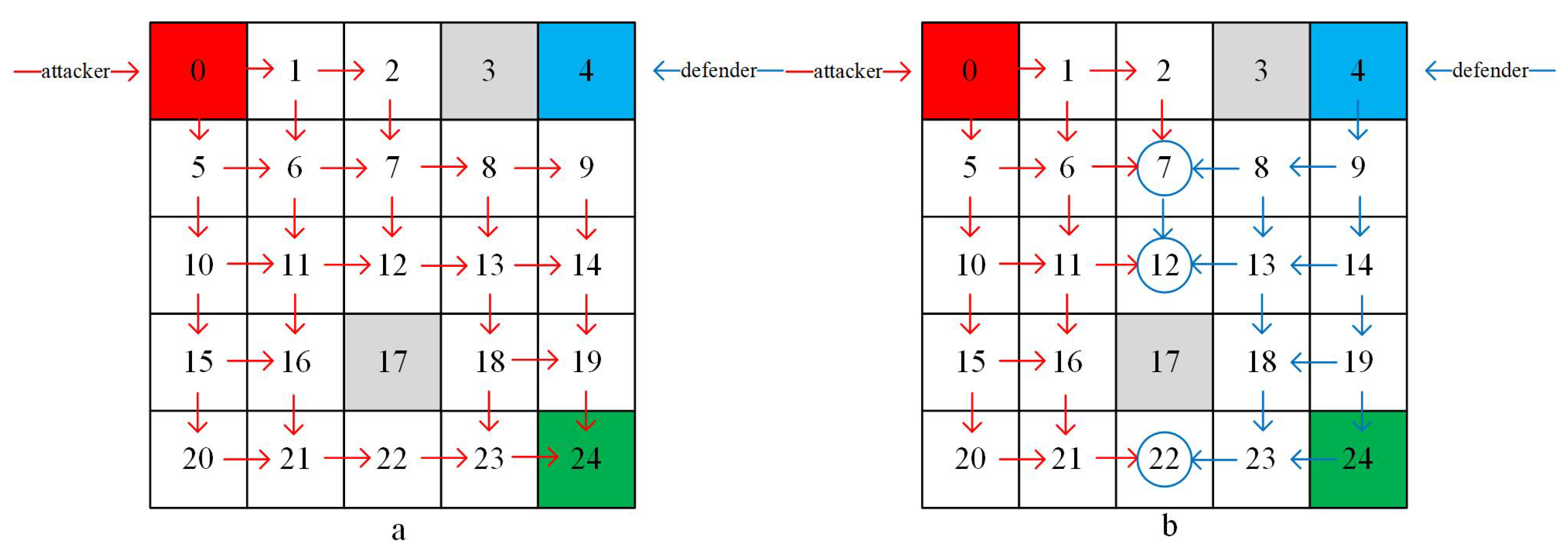

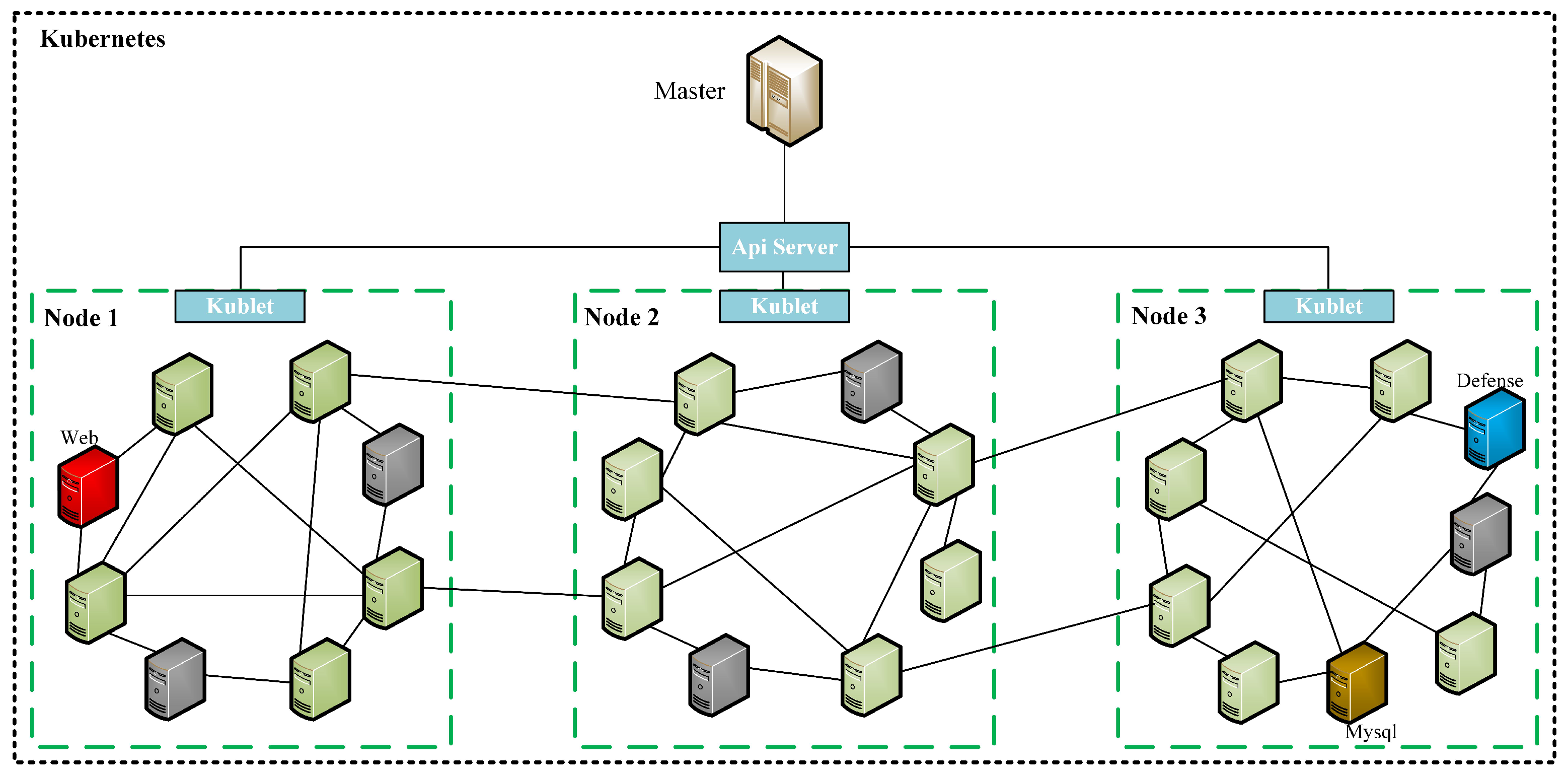
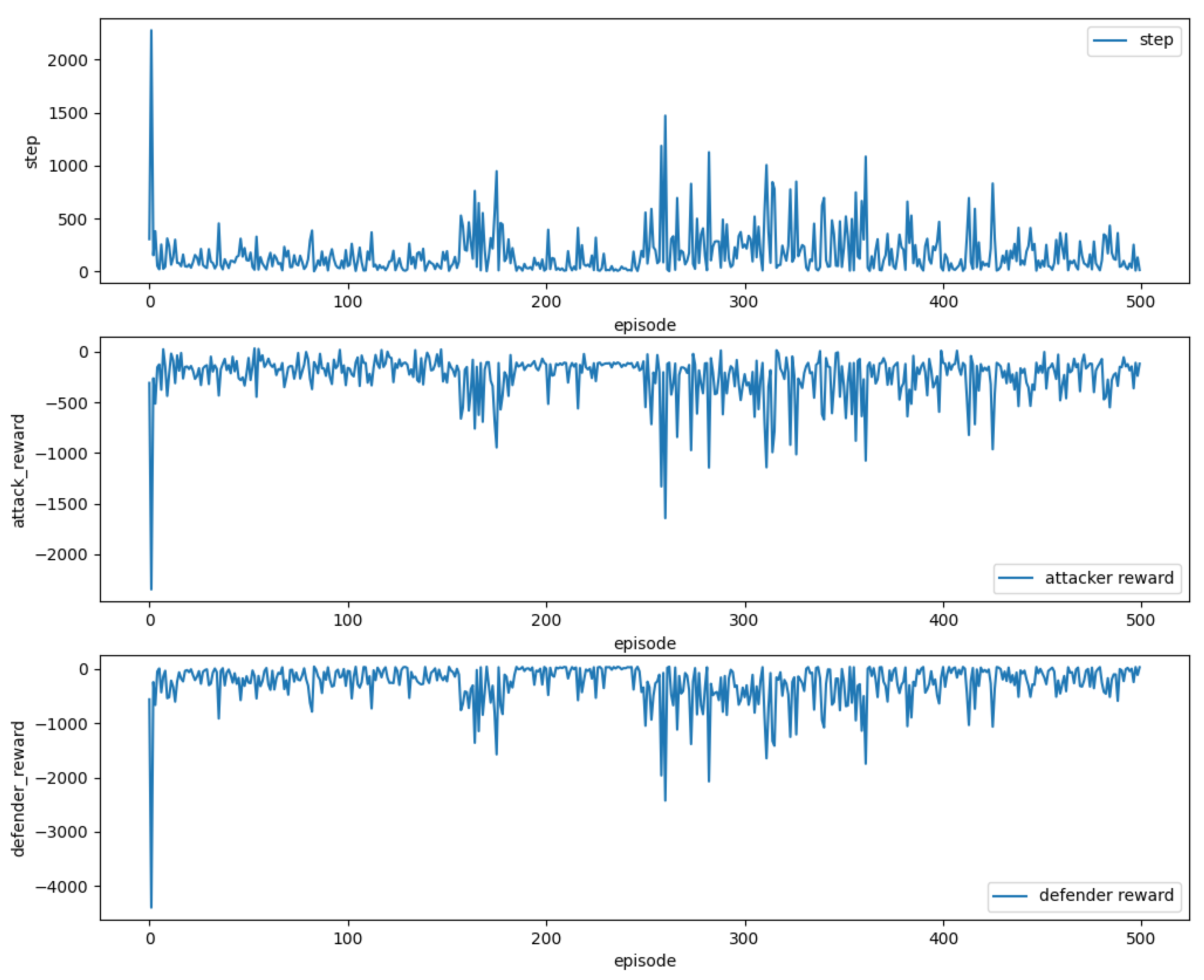
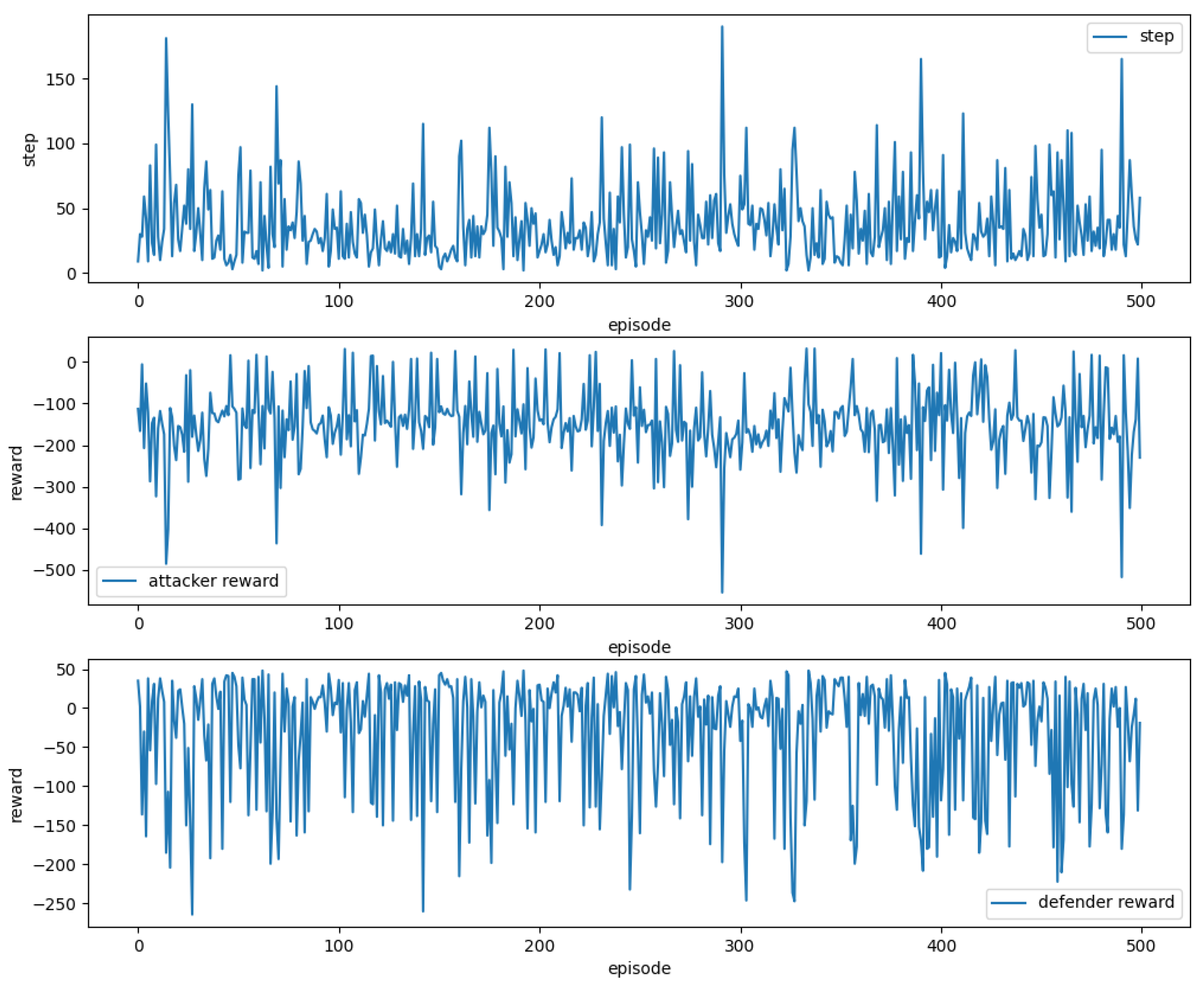
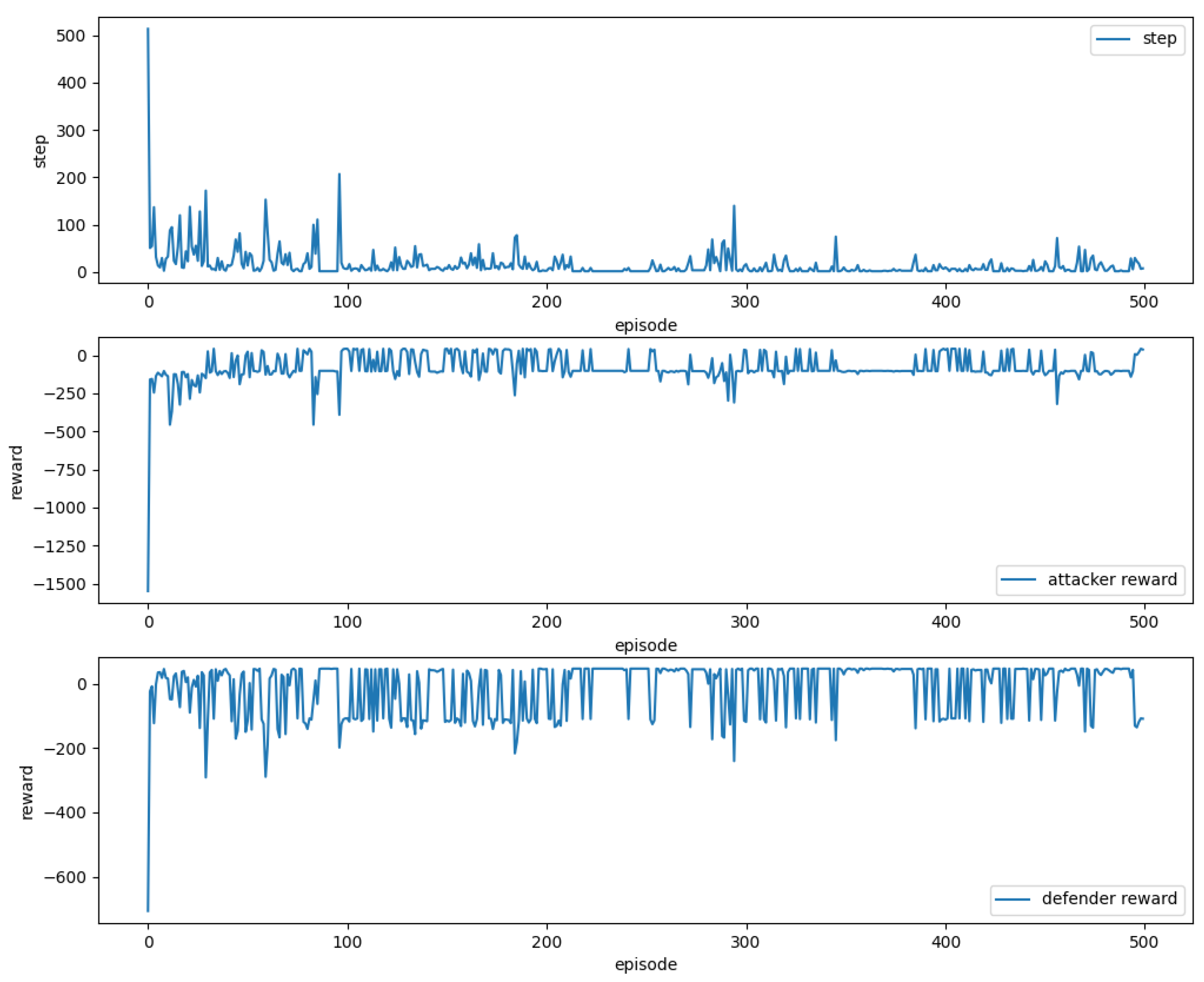
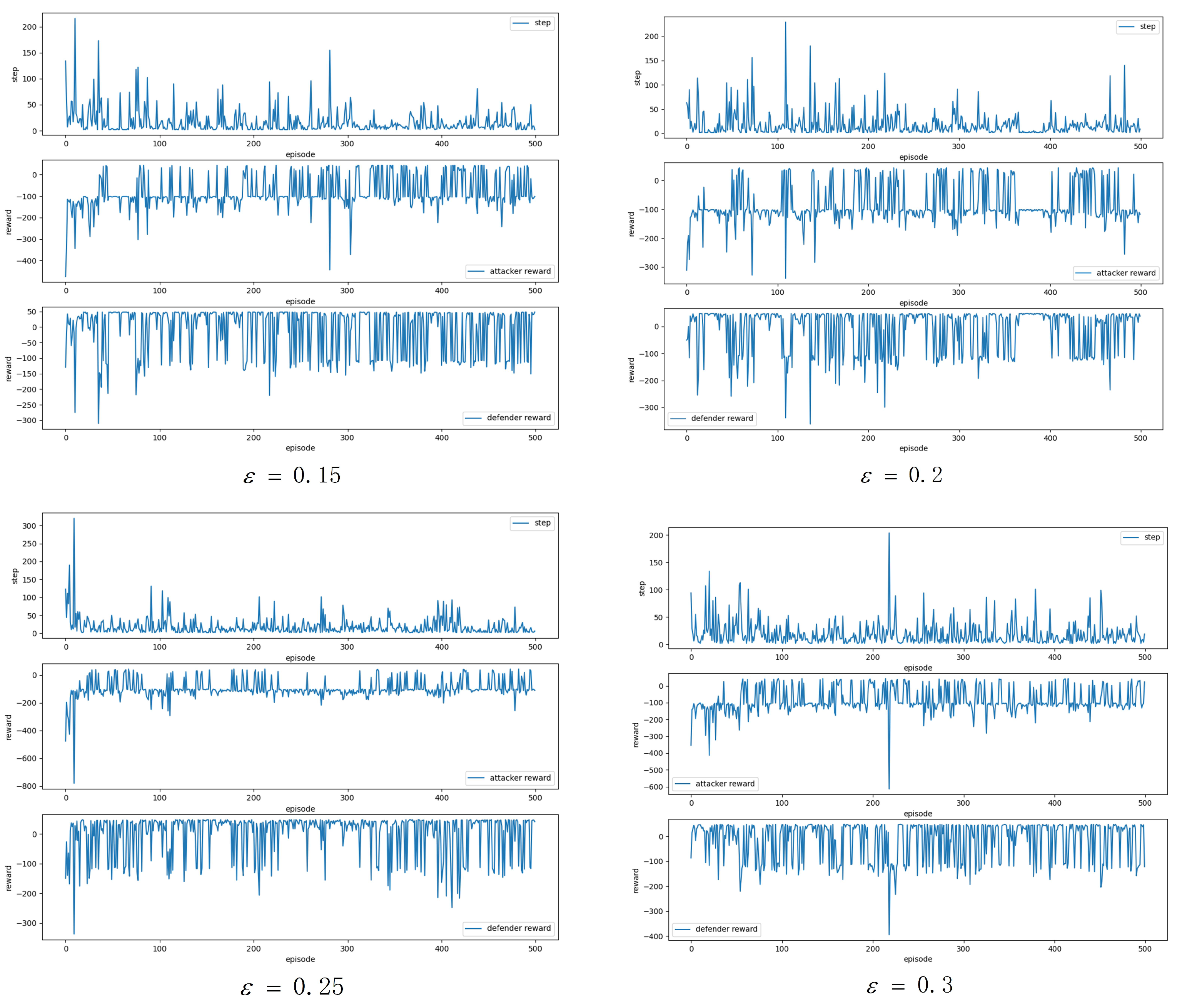
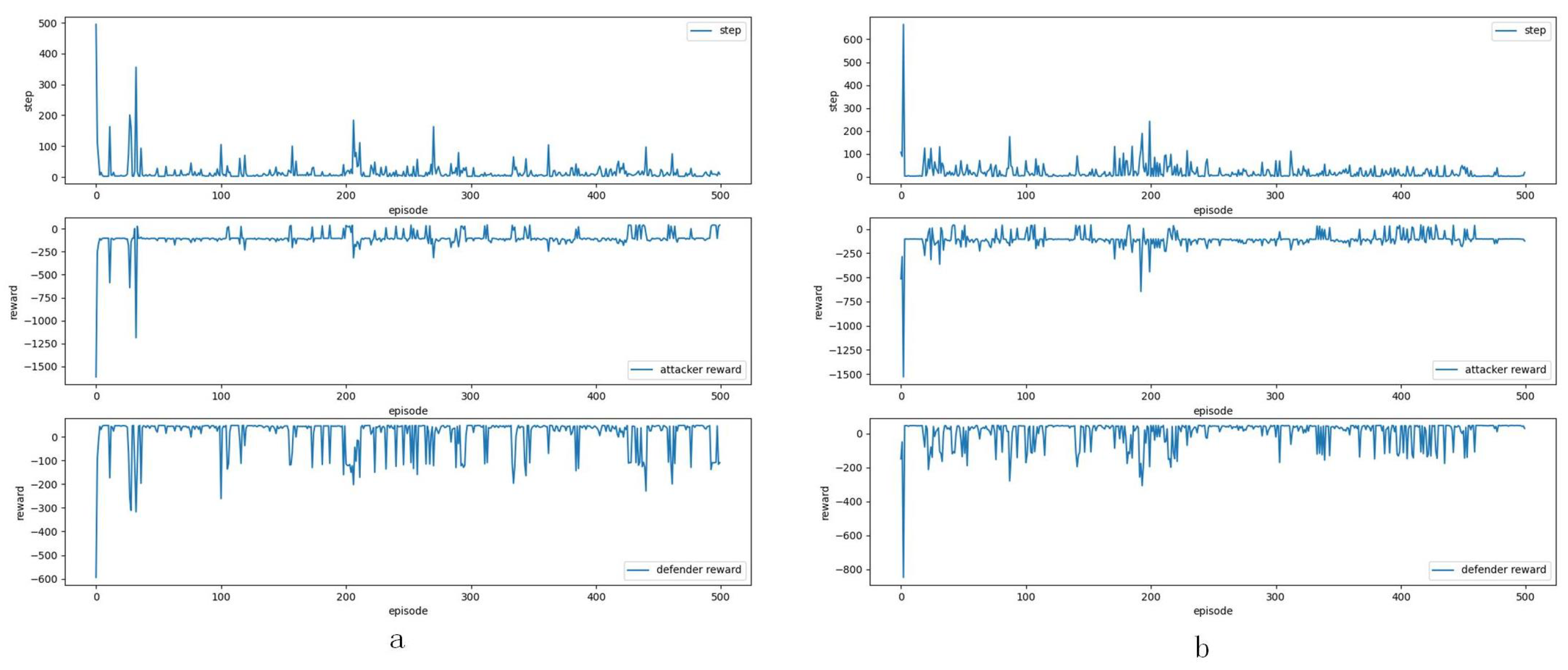


| Item | Configuration |
|---|---|
| OS | Windows 10 Professional |
| CPU | Intel Core i7-8700 @3.20 GHz |
| GPU | Intel(R) UHD Graphics 630 |
| Memory | 24 GB RAM |
| Python Edition | 3.9.11 |
| Platform | Pycharm Community Edition |
| Simulation Parameter | Configuration |
|---|---|
| Players’ Action Set | [0, 1, 2, 3] |
| Max Episode | 500 |
| Max Step | 10,000 |
| Hyper Parameter | 0.1 |
| Learning Rate | 0.001 |
| Discount Factor | 0.99 |
| Paper | Model | Method | Result |
|---|---|---|---|
| Reference [20] | Attack Graph | Game Theory | Nash Equilibrium deployment Strategy |
| Reference [25] | Maze + Attack Graph | MDP + Single-agent RL | Nash Equilibrium deployment Strategy |
| Reference [23] | Attack Graph | Single-agent RL | Optimal deployment policy |
| ours | Maze | Game Theory + Multi-agent RL | Optimal deployment location |
Disclaimer/Publisher’s Note: The statements, opinions and data contained in all publications are solely those of the individual author(s) and contributor(s) and not of MDPI and/or the editor(s). MDPI and/or the editor(s) disclaim responsibility for any injury to people or property resulting from any ideas, methods, instructions or products referred to in the content. |
© 2023 by the authors. Licensee MDPI, Basel, Switzerland. This article is an open access article distributed under the terms and conditions of the Creative Commons Attribution (CC BY) license (https://creativecommons.org/licenses/by/4.0/).
Share and Cite
Kong, G.; Chen, F.; Yang, X.; Cheng, G.; Zhang, S.; He, W. Optimal Deception Asset Deployment in Cybersecurity: A Nash Q-Learning Approach in Multi-Agent Stochastic Games. Appl. Sci. 2024, 14, 357. https://doi.org/10.3390/app14010357
Kong G, Chen F, Yang X, Cheng G, Zhang S, He W. Optimal Deception Asset Deployment in Cybersecurity: A Nash Q-Learning Approach in Multi-Agent Stochastic Games. Applied Sciences. 2024; 14(1):357. https://doi.org/10.3390/app14010357
Chicago/Turabian StyleKong, Guanhua, Fucai Chen, Xiaohan Yang, Guozhen Cheng, Shuai Zhang, and Weizhen He. 2024. "Optimal Deception Asset Deployment in Cybersecurity: A Nash Q-Learning Approach in Multi-Agent Stochastic Games" Applied Sciences 14, no. 1: 357. https://doi.org/10.3390/app14010357
APA StyleKong, G., Chen, F., Yang, X., Cheng, G., Zhang, S., & He, W. (2024). Optimal Deception Asset Deployment in Cybersecurity: A Nash Q-Learning Approach in Multi-Agent Stochastic Games. Applied Sciences, 14(1), 357. https://doi.org/10.3390/app14010357





